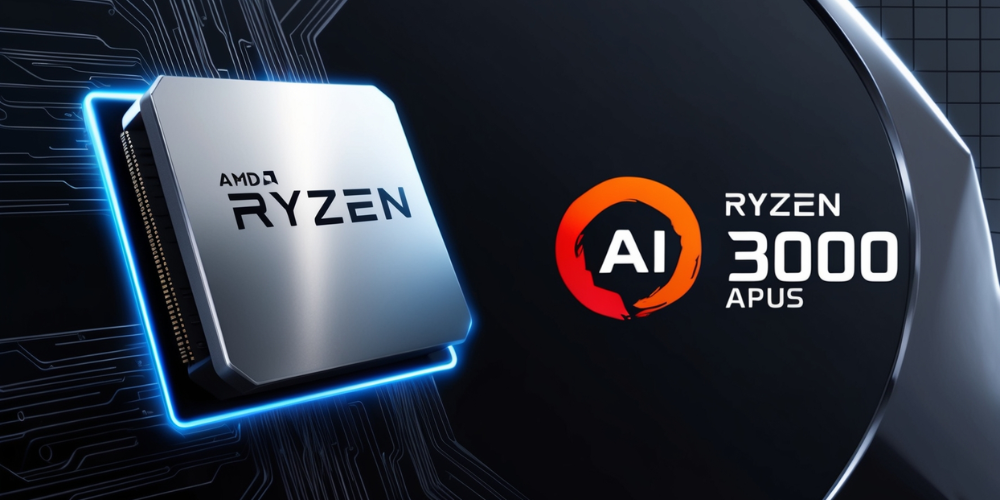Revolutionizing Integrated Graphics: AMD's Ryzen AI 300 APUs and Their Game-Changing Features
Sep-16-2024

In the continuously transforming realm of gaming and computer graphics, AMD consistently pushes boundaries to enhance user experiences. The latest arrival in this endeavor is the Ryzen AI 300 APUs, which have made waves with the introduction of new technologies that promise to elevate performance metrics like never before. Among these enhancements are the Fluid Motion Frames 2 (AFMF 2) and Variable Graphics Memory (VGM), both designed to radically improve frame rates for an immersive gaming experience. This article delves into the details and benefits of these features, guiding you on how to optimize your setup for maximum enjoyment.
Introduction to Ryzen AI 300 APUs
The AMD Ryzen AI 300 APUs, launched in July, are a significant step up in computing performance, featuring the latest RDNA 3.5 architecture. These chips are designed for users who require powerful graphics capabilities, whether for gaming, content creation, or general computing tasks. Equipped with cutting-edge technology, they promise to redefine the way games are played, especially when partnered with the latest software innovations.
What are Fluid Motion Frames 2 (AFMF 2)?
Fluid Motion Frames 2, abbreviated as AFMF 2, is a revolutionary technology aimed at enhancing frame rates in games. Launched shortly after the Ryzen AI 300 APUs, AFMF 2 leverages advanced algorithms to interpolate frames in real-time. This feature is tailored for various graphics processing units (GPUs), including those built on the RDNA 2, RDNA 3, and RDNA 3.5 architectures.
Significance of AFMF 2 in Gaming
So why should gamers care about Fluid Motion Frames 2? By utilizing this technology, users can experience a marked increase in FPS—sometimes up to 78%—in demanding titles. An example of this can be seen in Cyberpunk 2077, where enabling AFMF 2 sees performance soar to nearly 100 FPS at 1080p resolution with a Balanced FSR preset. This makes high-octane gaming not only feasible but enjoyable.
The Role of Variable Graphics Memory (VGM)
Another pivotal feature accompanying the Ryzen AI 300 APUs is Variable Graphics Memory. VGM allows users to dedicate a specific amount of system RAM to the integrated graphics unit (iGPU), overcoming limitations that traditional shared memory setups face. This feature is particularly beneficial for gaming scenarios where high memory bandwidth is essential.
How Does VGM Work?
With Variable Graphics Memory, users can refine their gaming experience by selecting memory allocation according to their system's specifications. This feature provides options to allocate memory from low, medium, to high settings, allowing for customization based on the available system resources. For instance, a setup with 32 GB of RAM can have memory settings tweaked to enhance graphics performance significantly.
Performance Improvements with Elevated Memory
When you allocate more memory to the integrated GPU, the performance improvement can be quite substantial. The Ryzen AI 300 APUs can seamlessly run games with high VRAM requirements—such as “Guardians of The Galaxy”—which typically necessitates 3 GB VRAM to operate effectively. This is particularly impressive given the limitations of default memory settings. By addressing these constraints, VGM can drastically enhance the gaming experience.
The Importance of the Adrenalin Software Suite
The AMD Adrenalin software suite is pivotal for users aiming to tap into the entire power of their Ryzen AI 300 APUs. Recent updates to the software include the introduction of AFMF 2 and enhancements to VGM, making it easier for gamers to customize performance settings effectively. The intuitive UI allows users to toggle between options seamlessly, leading to a smoother gaming experience.
Additional Features and Benefits
The latest technical preview driver also bundles several other features aimed at performance improvement, including Anti-Lag 2 and HYPR-Tune. These technologies work in harmony with AFMF 2 and VGM, providing a comprehensive suite that ensures gameplay is not only fluid but also free from bottlenecks and delays.
Accessibility and User Feedback
The launch of these features is noteworthy not simply for the technology but also for AMD's commitment to its user base. As these features are rolled out in a technical preview phase, users are encouraged to share feedback. This collaborative approach highlights AMD's intent to refine these features continually based on real-world usage, leading to optimizations that benefit everyone.
How to Enable AFMF 2 and VGM
Activating AFMF 2 and Variable Graphics Memory is straightforward through the Adrenalin software. Users can navigate to the gaming tab to enable AFMF 2, ensuring Anti-Lag is also turned on for a lag-free experience. Meanwhile, memory allocation can be selected under the Performance tab. With just a few clicks, users can empower their APU setup and witness immediate enhancements in visual fidelity and performance.
Target Audience for These Features
Both AFMF 2 and VGM primarily target gamers who demand high performance from their systems without investing in expensive dedicated graphics components. Additionally, content creators who rely heavily on rendering and graphical performance stand to benefit, making these technologies integral to a wider audience.
The Future of AMD's Graphic Technologies
As AMD continues to innovate, the potential for further advancements in graphics technologies remains exciting. The introduction of these features sets the stage for future enhancements in gaming and graphics performance, with expectations for even more sophisticated tools on the horizon. Users can look forward to the continued evolution of the graphics landscape.
How To Download and Install
Users looking to leverage the latest driver and features can find the software available for download directly from AMD's website. Installation is user-friendly, allowing gamers to quickly set up their systems for optimized performance.
Conclusion: A Game Changer in Integrated Graphics
The arrival of AFMF 2 and Variable Graphics Memory in the Ryzen AI 300 APUs marks a major progression in cohesive graphics technology. These features not only enhance frame rates substantially but also enable users to enjoy games that were once thought to require dedicated GPU hardware.
Final Thoughts
As gaming and graphics technology continues to evolve, AMD’s initiatives represent a forward-thinking approach that prioritizes both performance and user experience. The Ryzen AI 300 APUs stand as a testament to AMD's dedication to providing top-tier technology at a consumer-friendly price point, empowering gamers and creators alike to explore new horizons in their digital experiences.







